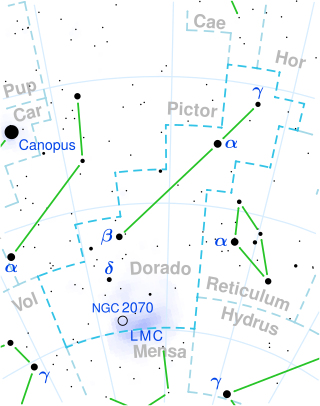Kappa Doradus
Suspected variable in the constellation Dorado From Wikipedia, the free encyclopedia
Kappa Doradus, Latinized from κ Doradus, is a solitary star[16] located in the southern constellation Dorado. It is faintly visible to the naked eye as a white-hued point of light with an apparent magnitude of 5.28.[2] The object is located relatively close at a distance of 220 light-years based on Gaia DR3 parallax measurements[1] and its distance from the Solar System is not changing, having a somewhat constrained heliocentric radial velocity of 0.00 km/s.[6] At its current distance, Kappa Doradus' brightness is diminished by two-tenths of a magnitude due to interstellar extinction[17] and it has an absolute magnitude of +1.15.[7]
| Observation data Epoch J2000.0 Equinox J2000.0 (ICRS) | |
|---|---|
| Constellation | Dorado |
| Right ascension | 04h 44m 21.17834s[1] |
| Declination | −59° 43′ 57.8563″[1] |
| Apparent magnitude (V) | 5.28[2] (5.27 - 5.30)[3] |
| Characteristics | |
| Spectral type | A8 IV[4] |
| B−V color index | +0.20[5] |
| Variable type | suspected δ Scuti[3] |
| Astrometry | |
| Radial velocity (Rv) | 0.00±3.70[6] km/s |
| Proper motion (μ) | RA: +23.860 mas/yr[1] Dec.: +39.974 mas/yr[1] |
| Parallax (π) | 14.8207±0.0795 mas[1] |
| Distance | 220 ± 1 ly (67.5 ± 0.4 pc) |
| Absolute magnitude (MV) | +1.15[7] |
| Details | |
| Mass | 1.78+0.36 −0.20[8] M☉ |
| Radius | 2.88+0.21 −0.19[9] R☉ |
| Luminosity | 26.6[10] L☉ |
| Surface gravity (log g) | 3.79±0.08[9] cgs |
| Temperature | 7,623±123[11] K |
| Metallicity [Fe/H] | −0.18[12] dex |
| Rotational velocity (v sin i) | 230[13] km/s |
| Other designations | |
| κ Dor, 12 G. Doradus[14], NSV 16162, CPD−59°376, FK5 2354, GC 5810, HD 30478, HIP 22040, HR 1530, SAO 233664, TIC 220414802[15] | |
| Database references | |
| SIMBAD | data |
The object has been given many different classes. Houk & Cowley (1975) gave a class of A8/9 III/IV,[18] indicating that it is an evolved A-type star with the characteristics of an A8 and A9 star and the blended luminosity class of a giant star and a subgiant. It has also been given a class of A8 IV and A5 III,[4][19] indicating either a slightly evolved subgiant or an evolved giant star. Kappa Doradus has 1.78 times the mass of the Sun[8] and 2.88 times the radius of the Sun.[9] However, this is only its polar radius, as it has an equatorial bulge 26% greater than its polar radius.[20] It radiates 26.6 times the luminosity of the Sun[10] from its photosphere at an effective temperature of 7,623 K.[11] Kappa Doradus is metal deficient with an iron abundance 66.1% of the Sun's or [Fe/H] = −0.18.[12] Like many hot stars it spins rapidly, having a projected rotational velocity of 230 km/s,[13] which causes the aforementioned oblation.[20]
Kappa Doradus variability was first observed in 1981 by astronomer H. M. Matizen.[21] In the paper, it is used as a comparison star for Alpha Doradus. Matizen found out that Kappa Doradus show Delta Scuti-like amplitudes of 0.03 magnitudes in the visual passband within hours.[3] As of 2004 however, it has not been confirmed to be variable.[22]
References
Wikiwand - on
Seamless Wikipedia browsing. On steroids.

